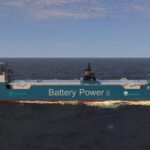Energy News Beat
Once a skeptic of nuclear energy, Energy and Technology Co-Chair State Rep. Jonathan Steinberg, D-Westport, is now one of its staunchest supporters.
Steinberg told CT Examiner this week that, like many of his contemporaries, he questioned the benefits of using nuclear energy. But those concerns have been alleviated through research, talking to field experts and visiting nuclear facilities throughout the country. Steinberg visited a power plant in South Carolina in November while attending the National Council of State Legislators’ quarterly meeting.
“When I first came to the legislature, I didn’t know about energy. Like anyone else, I flipped the switch and the lights came on,” he said. “Then, we were a little skeptical of nuclear. We thought it was yesterday’s kind of energy. But as soon as I started doing my homework I discovered that nuclear was a viable option — it’s carbon free, and if you do a really good job managing the environmental and safety concerns, it really should be considered in the mix.”
Steinberg noted that nuclear power can “also reduce the risks of blackouts and brownouts.”
He also said he favors and would advocate for a third reactor at the Millstone Nuclear Power Station in Waterford, the state’s only such facility.
The 2,073-megawatt Millstone site, owned by Dominion Energy, covers about 500 acres. According to the company, the plant produces enough electricity to power 2 million homes with low-cost and carbon-free electricity that helps the state fulfill its carbon-reduction goals.
According to the U.S. Energy Information Administration, nuclear power provided 37 percent of in-state generation in Connecticut in 2022. Connecticut ranks among the 10 states with the highest share of electricity generated from nuclear power, according to the EIA.
Steinberg understands the timetable of having a third reactor — which could translate into powering even more homes — is up in the air. At best guess, he said, the process of placing a third reactor at the facility could take years, maybe more than a decade. However, Steinberg said, it’s something worth pursuing and investigating now.
“I know there are a bunch of obstacles related to nuclear, not just the environmental and safety ones, but the economic ones too,” the lawmaker said. “If you look at what has happened in Georgia and North Carolina, they’ve had huge overruns in traditional nuclear reactors, and they’ve abandoned the concept. We have not built a new nuclear reactor in the United States for a long time. There are genuine hurdles there. I am hopeful for small modular reactors [or SMR’s] which would use less concrete, which is one of the big expenses.”
Steinberg said he favors having an SMR at Millstone, but supports having a traditional reactor as well.
Currently, only Russia and China have SMRs in their plants, but the U.S. Department of Energy has said it wants to deploy SMRs at home by the end of this decade or by early 2030.
According to the Department of Energy, advanced SMRs offer numerous advantages over traditional reactors, including offering a relatively small physical footprint, reduced capital investment and the ability to be placed in locations not possible for larger nuclear plants. SMRs, the agency said, also offer distinct safeguards, security and nonproliferation advantages.
The practicality of having an SMR at Millstone in the short-term, Steinberg said, is wishful thinking.
“I would say, realistically, it might be 2040,” he said. “Maybe we could cut a few years off; that would mean some basic coalescence of the industry, which a lot of people are betting on. A lot of people want to see this happen.”
The state Department of Energy and Environmental Protection would have to approve any plans to have another reactor at Millstone.
In a statement, DEEP spokesperson Will Healey said, “The decision to possibly pursue adding an additional reactor to the Millstone facility is up to the site owner, Dominion. In our deregulated market, these kinds of decisions are market decisions to be made by the market participants, if they deemed it made business sense to do so. DEEP continues to explore opportunities and policy options to incent any low carbon sources of energy.”
Dominion, in a statement to CT Examiner this week, said it anticipates SMRs will be the wave of the future and is on board with such technology.
“As for nuclear technologies, Dominion Energy is exploring SMRs as an option in the next decade and beyond. This technology is still being developed and new advanced nuclear designs may be ready for large-scale deployment by the early 2030s,” the statement read. “SMRs provide the potential to expand capacity at existing nuclear sites. … Dominion Energy has a great history of providing carbon free energy to the state of Connecticut and we look forward to the opportunity to work with the Energy & Technology Committee and policymakers on constructive solutions to continue to operate the current units and to discuss the policy environment that would be necessary to take full advantage of the potential for nuclear power in meeting increased energy demand as well as the state’s decarbonization goals.”
Steinberg said there are many unknowns when it comes to the cost of reactors and, potentially, SMRs, but that It’s something to keep an eye on.
“The project overruns and the projects that have been tried in the United States in recent years are a cause for alarm,” he said. “They’ve gotten to the point where they can’t complete the project at a reasonable cost and they wouldn’t be able to recover. That is one of the reasons why some are not overly excited about jumping into the new nuclear facility [concept]. So, we need to get to a point where the economic formula for building a new plant makes sense so that it can attract investors.”
ENB Top News
ENB
Energy Dashboard
ENB Podcast
ENB Substack
The post Steinberg Embraces Nuclear Energy, Supports Third Nuclear Reactor at Millstone appeared first on Energy News Beat.








